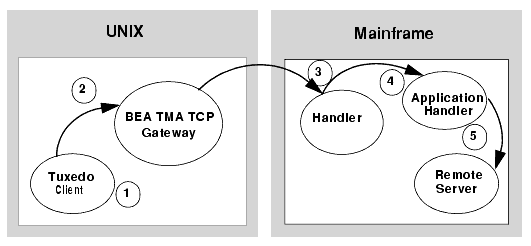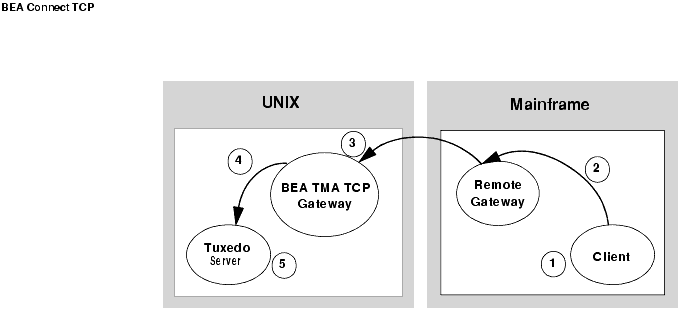CICS User Guide
|
|
|
Get Adobe Reader |
Configuring the TMA TCP Security
The TMA TCP product supports a security feature that allows a requester from BEA Tuxedo services to pass a user ID through the CICS server interfaces for verification through a third-party security package. The following topics explain the how to set up security:
Service Request Processing with Security
The following sections describe the process flow for security verification of a service request.
Security Checking from UNIX to Mainframe
Figure 3-1 depicts the process flow for security verifications from TMA TCP for CICS on UNIX to a mainframe.
Figure 3-1 Security Checking for UNIX to Mainframe Transactions
- When the TMA TCP gateway client program performs a
tpinit(), the user's Tuxedo identity is validated against thetpusrfile. - When the client program issues a
tpcall()ortpacall(), Tuxedo verifies (against thetpaclfile) the user is authorized to invoke the gateway service. - When the gateway establishes the initial connection, connection security information (specified as
RMTNAMEandPASSWORDin theGWICONFIGfile) is passed from the TMA TCP gateway to the remote gateway. If theRMTNAMEandPASSWORDvalues match the values configured on the remote gateway, the connection is established. With each request, the TMA TCP gateway passes the user's Tuxedo identity to the remote TMA TCP for CICS gateway (to the Handler).
Note: To pass authority checking, the user's Tuxedo identity must match the mainframe user ID exactly.
- The remote TMA TCP for CICS gateway Handler initiates an Application Handler to act on behalf of the specified user ID.
Note: You may need to update your surrogate security definitions to allow the successful invocation of the CICS application program (EXEC CICS START TRANSID). See your mainframe security administrator if your site has this requirement.
Security Checking from Mainframe to UNIX
Figure 3-2 depicts the process flow for security verifications from a mainframe to TMA TCP gateway on UNIX.
Figure 3-2 Security Checking for Mainframe to UNIX Transactions
- The user ID, established at mainframe log in, is checked by system security to verify that the user has permission to start a client transaction.
- The user ID is checked by system security to verify that the user has permission to send a request to the gateway.
Note: To pass authority checking, the user's Tuxedo identity must match the mainframe user ID exactly.
Setting Up Security for TMA TCP for CICS
The TMA TCP for CICS product supports enhanced security. This interface allows a requester from BEA Tuxedo services to pass a User ID through the CICS server interface for authorization through your security package. For field definitions, refer to the Configuring and Administering BEA TMA TCP for CICSsection.
Securing User Connections
Complete the following tasks to enable the security feature for each connection.
When
SECURITY=Y, TMA TCP for CICS verifies theACCOUNTandPASSWORDvalues from the User Connection Account match theRMTACCTandPASSWORDvalues in the TMA TCP gatewayGWICONFIGfile*FOREIGNsection. If these values do not match andSECURITY=Y, a security error occurs.If
SECURITY=N, the gateway allows a connection without any verification.
Securing Inbound Services
Complete the following tasks to enable the security feature for each inbound service.
Securing Outbound Connections from CICS to UNIX
Complete the following tasks to enable the security feature for each outbound connection.
Verify that the parameter values for
ACCOUNTandPASSWORDin the Requester screen match theRMTACCTandPASSWORDvalues in the*FOREIGNsection of the TMA TCP gatewayGWICONFIGfile.When
SECURITY=Y, the requester program sends theACCOUNTandPASSWORDto the remote UNIX system on connection initiation. WhenSECURITY=N, the gateway attempts to make a connection without any verification.
Securing Outbound Connections from CICS to CICS
Complete the following tasks to enable the security feature for each outbound connection.
Verify that the parameter values for
ACCOUNTandPASSWORDin the Requester screen match theACCOUNTandPASSWORDvalues in the User Connection Account screen.When
SECURITY=Y, the requester program sends theACCOUNTandPASSWORDto the remote CICS system on connection initiation. WhenSECURITY=N, the gateway attempts to make a connection without any verification.
Securing Outbound Connections from CICS to IMS
Complete the following tasks to enable the security feature for each outbound connection.
Verify that the parameter values for
ACCOUNTandPASSWORDin the Requester screen match theACCOUNTandPASSWORDvalues in theGATEWAYTYPE=REMOTEstatement.When
SECURITY=Y, the requester program sends theACCOUNTandPASSWORDto the remote IMS system on connection initiation. WhenSECURITY=N, the gateway attempts to make a connection without any verification.
Securing Outbound Services
Complete the following tasks to enable the security feature for each outbound service.

